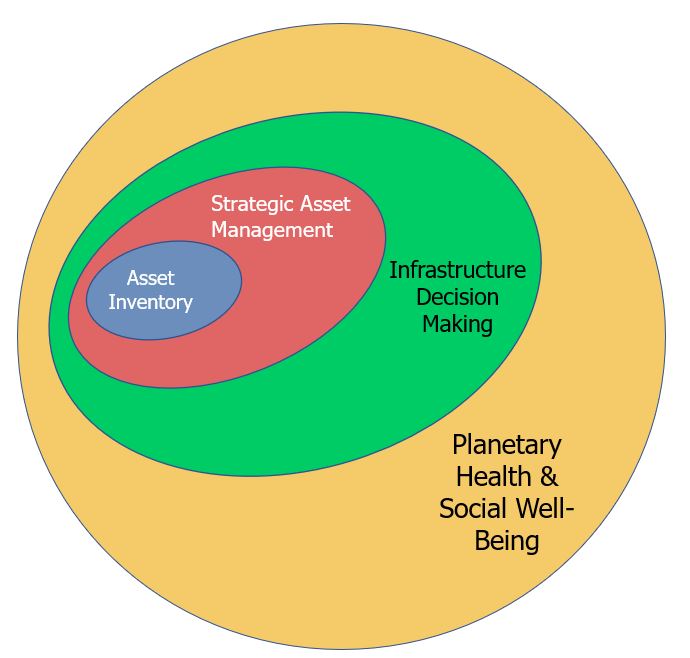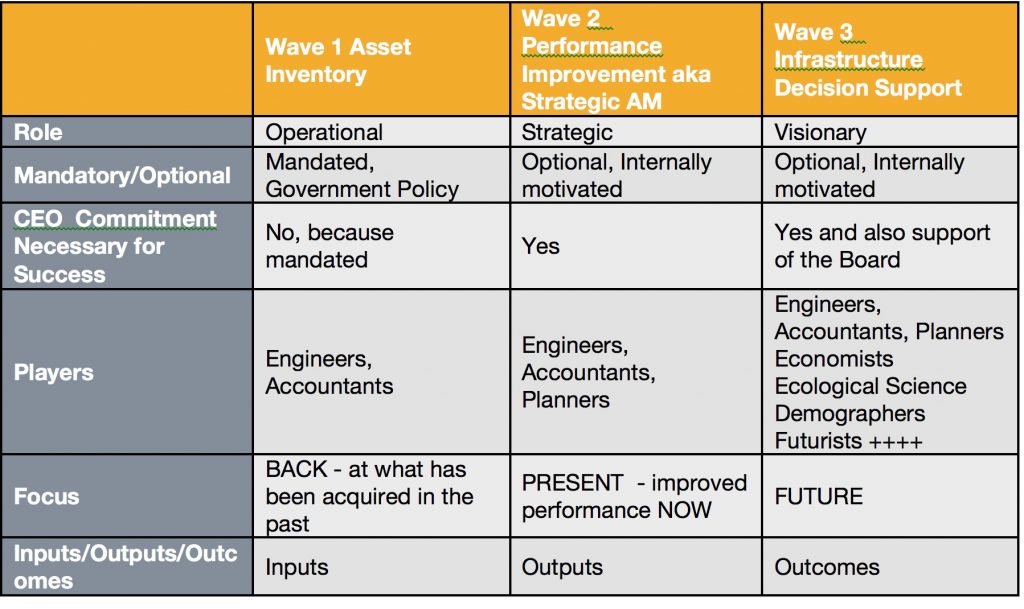
I have just been to the 30 year celebration of the Institute of Asset Management (IAM) in London, where we also marked ten years of ISO 55000. This was held jointly with the Global Forum on Maintenance and Asset Management (GFMAM) – representing AM and AM-minded maintenance societies worldwide – with representatives from IPWEA and the Asset Management Council. A time to reflect as well as celebrate!
Russ Seiler of Grant Public Utility District (one of the Columbia River hydro utilities in the Pacific North West) reflected on his journey since 2016. Starting from scratch as an Asset Management lead, under Russ the team at Grant has looked at asset inventory, Wave 1, and the absence of basic asset data. It then focused on the AM ‘system’, as in ISO 55000, and the idea of building AM artefacts. (Wave one-and-a-half?) But, encouraged by Penny’s 2023 book on the beginnings of AM, he realised that neither were really the point.
His conclusion after seven years? “If your asset management program never affects the money being spent on assets, your program should and will be terminated.” AM creates the machine that produces the plan, a better plan for the assets. Everything else is just a means to that end.
It’s the AMP process, ok.
I have trained many 1000s in the last 14 years, in the USA and elsewhere. And that’s what I have found, too. Too many get caught up in asset data – which is important, sure – and documents such as the AM Policy and SAMP, which are also important. But that is never what Penny meant by Asset Management.
And ‘plan’ doesn’t just mean what proactive maintenance you should do, or what you need to spend capital on to sustain your existing asset base. It’s also what if any new infrastructure we require. It’s whole of life and system-wide. It’s big.
Have we been tinkering at the edges while the world changes around us?
My boss has been heard to say that when they started the company in 1997, he assumed that within a few years we would have figured everything all out and would just be applying the Asset Management manual. Instead, we learn something new on every project… Twenty five years on, that’s certainly true for me.

My old colleague John Lavan described what we have to do as tackling problems, not solving puzzles.
A puzzle is (in his terms) something where you already know what you have to do to solve it. It’s a rule-based game, like school-level mathematics. Apply this methodology and it will come out right.
Whereas we are faced with problems, where we don’t necessarily know what to do, or if there is a good solution.
As soon as we work out a useful approach on something, we’re faced with having to evolve it further. That is, even if we’re lucky enough to have a good way to start.
Fellow Talking Infrastructure Board member Lou takes this further. There are puzzles, which don’t resemble Asset Management, but perhaps some engineers still wish for; problems, which seems to be our AM world; and predicaments, where there maybe isn’t a solution at all.
I’d like to think building an asset inventory is a puzzle that we already know how to solve. Plenty of individuals don’t yet know, of course, but that feels like just an issue of communication.
On the other hand, what’s an effective strategy for Asset Management in a particular organization? We know the principles (alignment to corporate targets, the Six Box Model of elements), but that’s merely the opening tool kit. Making Asset Management business as usual is a problem, still, for just about everyone. Too many variables and different nuances.
Old age is a predicament. And as for climate change? Maybe, given human psychology, it’s a predicament, not simply a problem.

To coincide with our presentation on the Waves of Asset Management at the IAM Global Conference on June 15, Talking Infrastructure launches: TIki. The wiki for strategic Asset Managers.
To being with, while we build up the content, it’s read-only, but we invite you to join in with further development.
Organized by Wave, we aim to build up an unrivalled knowledge base on Strategic Asset Management, including access to the best of… Strategic Asset Management, Penny’s biweekly newsletter from 1999 to 2014, as well as more on Building an Asset Management Team, and through DAN and other networking with AM leads in North America and beyond. And don’t miss an episode of The Story of Asset Management, which for Penny was always about being strategic.
On Wave 3, Infrastructure Decision Making, we are using TIki to capture thinking on future friendly assets – better questions, some of them hard, particularly in this era of ‘Build Back Better’ trillions.
For Wave 4, we aim to start to nibble away at how to integrate infrastructure and planetary health, starting with the initiatives at Blue Mountains City Council.
TIki already has many pages, and many more to come. It’s easy to follow your curiosity, as well as backtrack via the trace.
Click on TIki in the top menu bar, and start your exploration now!

How do we get AM into decisions and projects for new assets?
I fear we haven’t quite got there yet. The lure of shiny new things means that even in those organisations where Asset Management is almost business as usual… any thinking about the whole ‘lust to dust’ lifecycle management, even basic on-going costs, goes out the window as soon as opportunities to access money for new (such as Biden’s 2021 Infrastructure Plan) arise.
It’s almost as if organisations can tolerate Asset Management – as long it does not impinge on their fun.
And so we continue to build long-term liabilities.
Wave 3 is ensuring that Asset Management, and Asset Managers, have their seat at the top table in decisions about growth and shiny new things. And once we are there, to ask very hard questions about both of them.
I would like to explore how we get to be at that table, and that ‘future friendly assets’ start, but don’t end, with a healthy scepticism about building anything new.
- What are they really going to cost over their whole life?
- Who really benefits from them?
- What do we rule out by investing in them, as opposed to something else?
- And what might we actually destroy in the process?
How do we make sure we are at the table to be able to ask them?

For a longer article on what goes wrong when Asset Management is not on the table, please see:
In May 2018, Penny Burns and Jeff Roorda wrote here about three ‘revolutions’ in Asset Management – later renamed ‘waves’, because that captures better the idea that one wave doesn’t supersede another.
Since then, we have discussed with each other and many others how Wave 1, ‘Asset Inventory’, is more successful if you already have in mind the vision of Wave 2, ‘Strategic Asset Management’ and how you are going to use all of the information you collect.
We have looked at what Asset Management practitioners need to develop to move on from this, to be able to look beyond our own organisations, to a bigger role in supporting our communities. We called this Wave 3, supporting better ‘Infrastructure Decision Making’.
We have even begun to imagine Wave 4.

As Penny puts it: whereas Wave 1 looked at WHAT we had, and Wave 2 looked at HOW we needed to manage it, Wave 3 started to ask WHO we were serving by our efforts. This has brought us now to start thinking more deeply about this question and about the next move, looking at the critical question of WHY.
As Asset Management practitioners, we have to ensure we are in the right positions of influence to be able to challenge existing infrastructure assumptions, which is what I think Wave 3 is all about. To look ‘up and out’, as Lou Cripps of RTD puts it.
But we can already spot that there is no point in being able to ask hard questions, if we don’t have the right questions to ask….
What do we mean by ‘better’?

Homo Sapiens is a pattern seeking species
it is how we advance. We seek patterns to find meaning. Me, I look for patterns in AM development. I seek the characteristics of the different stages (that I now think of as waves rather than as revolutions, as explained in the last post) and how each builds on the one before and takes us further. This helps me to see not only where we have been but also where we can go. Each wave has its own focus, viewpoint, key players and sources of support as well as constraints. Below is a table illustrating some of the characteristics of the first three waves that I see. What do you think?

Where we have been and where we are
Waves 1 and 2 you will readily recognise, for they reflect where we have been and where we are. Wave 3 is where we need to go next. This is the visioning stage where asset management teams, use their appreciation of ‘line of sight’ or the necessity for asset actions to support organisational objectives to guide decisions on both new and existing infrastructure. This is where AM teams need to anticipate, communicate, and prepare for the inevitable shifts in attitudes, governance and demand, that are now occurring and will continue to occur as demographics, climate and technology change. Turning around large infrastructure portfolios is not an overnight task. It takes intelligent planning and communication. This is Wave 3.
Where we are going
Communication, anticipation, action. In Wave 3 AM teams help their corporate managements to explicitly recognise that the asset portfolios and management practices they have now are a reflection of the past, and that the future will be very different from the past and will involve new thinking. This may seem obvious, but it is not necessarily happening at the moment. Sometimes it seems that it is easier to assume that nothing will change very quickly so we can continue doing what we have always done. And sometimes the lure of the new and shiny leads to adoption of the new without sufficient examination.
The Wave 3 challenge is not to jump straight into the new and exciting, but rather to determine how best to reduce the twin dangers of changing too early, and of moving too late.
The biggest change will require us to ask what changing circumstances and future communities will DEMAND of us, what the new needs will be, and not to look at new technology as merely an opportunity to change the way we SUPPLY the current needs of our customers and community.
From Supply to Demand. In the past most of the information we have needed for our decision making in asset management has been internally generated and recorded in our Asset Information Systems. This has been solely supply side information. We still need our supply side information. But this will not suffice. Knowing what we CAN do is not enough. We need also to look at what we MUST do. For this, we will increasingly require the ability to understand and anticipate future demand change. This is why our our asset management teams will need to expand to include the talents of many other professionals, as I have suggested in the table above.
Is your Asset Management Team prepared?
Is your Asset Management team prepared to tackle the third wave? If you are not sure, then a good place to start would be with “Building an Asset Management Team” by Ruth Wallsgrove and Lou Cripps. This will help you recognise not only requirements but also the many new possibilities. Here is a short excerpt “What kind of people does an AM team require?”
Note: When you buy “Building an Asset Management Team” you not only get the very latest thinking in AM teamwork, but you pave the way for future developments, for Ruth and Lou are donating all their proceeds (ALL, not just profits) to Talking Infrastructure.
So go ahead, click this link to get your copy. You can get a Kindle version for less than $10. In this case value greatly exceeds cost. It’s priced low to maximise the number of teams that can gain access. Spread the word!

I was wrong. Movement from maintenance to asset management, to strategic asset management is NOT a revolution. Why not?
In 2018, for the IPWEA’s online journal, Jeff Roorda and I sketched out what we saw as the general pattern of these individual journeys and what this suggested about where we would go next. At the time there was a lot of discussion about the third (and for some) the fourth industrial revolution. We needed a sexy title for our paper so we called it ‘The third AM Revolution’.
We saw AM moving from the pre-AM stage of maintenance only to the first stage of data collection, or ‘asset inventory’, to the second stage of performance and alignment, or what we call ’Strategic asset management’ – the stage we believe most of Australia is now in – to a new third stage, our ‘third revolution’ that we are calling ‘infrastructure decision support’.
We now see that ‘revolution’ was the wrong word.
Revolutions have connotations of what was previously important getting the chop – quite literally in the French Revolution! Although each of the three stages we identified are still important because they represent different mindsets and approaches, different groups of players and different techniques, they do not discard what went before. Instead they increase our understanding of their value and make them stronger.
Let’s see how that works.
0. Before AM there was maintenance. Maintenance specialists firmly believed in the value of their work, and they were right. Unfortunately they were unable to convince others, especially finance. When AM came along it provided a framework to demonstrate that not only was maintenance able to fix what was currently broken – it could also help prevent more breaking down in the future. That is why so many maintenance engineers were keen to see AM adopted by their organisations.
1. The first stage of AM, naturally, was to establish an asset inventory. We needed to know what we had to manage.
2. With enough basic data we were enabled to take the next step use the data collected for performance improvement. When we did this, we became much more aware of data quality and coverage. That first stage of data collection did not get the chop, now we wanted more. Instead of data being required simply for a mandated balance sheet (e.g. a storage location) it was increasingly seen as necessary, indeed essential for progress, and so demand for more data, and for data of a higher quality with greater coverage has continued.
3. The coming third stage is what will bring all of these stages – maintenance, data collection and performance improvement or strategic asset management – together, for it is at this third stage that asset managers finally reach the stage that they have desired for a long time. Asset management is able to get (and worth a) place at the board table!
So not a revolution. But what?
We could simply call them ‘three stages’ and be done with it. This, however, would not show the connection between them, how each builds on what went previously, so we are calling them waves, for like waves they build on each other and get stronger.
Why is this important?
Because now that it is so easy to access detailed information about the second wave of strategic asset management or performance improvement (IIMM, PAS55, ISO 55,000) there is a temptation is to dive in at this level. But without attention to the first wave of data collection and without strengthening the pre-AM stage of maintenance, such attempts lead to failure. Under-developed countries wanting, and needing, to do fast catch up with the developed world are at particular risk.
They are being pressured ‘to do asset management’ in order to get the strategic asset management, second wave, benefits but the importance of funding and training at the earlier stages, particularly maintenance is not being recognised and dealt with. Every stage – maintenance/pre-AM, data collection/asset inventory, and strategic asset management/performance improvement or alignment – requires a different focus, different tools, different groups of players.
I will talk about Wave 3 – where we go next – in a later post.
Q: Does this development pattern make sense to you?
Can you recognise it in your own organisation or others? Is it obvious, or do you see an alternative pattern to your own asset management journey?

Recent Comments